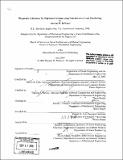| dc.contributor.advisor | Steven B. Leeb. | en_US |
| dc.contributor.author | DeNucci, Thomas W | en_US |
| dc.contributor.other | Massachusetts Institute of Technology. Dept. of Mechanical Engineering. | en_US |
| dc.date.accessioned | 2006-07-31T15:14:05Z | |
| dc.date.available | 2006-07-31T15:14:05Z | |
| dc.date.copyright | 2005 | en_US |
| dc.date.issued | 2005 | en_US |
| dc.identifier.uri | http://hdl.handle.net/1721.1/33576 | |
| dc.description | Thesis (S.M.)--Massachusetts Institute of Technology, Dept. of Ocean Engineering; and, (S.M.)--Massachusetts Institute of Technology, Dept. of Mechanical Engineering, 2005. | en_US |
| dc.description | Includes bibliographical references (leaves 87-88). | en_US |
| dc.description.abstract | Field studies have demonstrated that the Non-Intrusive Load monitor (NILM) can provide real-time indication of the condition of electro-mechanical systems on board naval vessels. Results from data collected from engineering systems on board USCGC SENECA (WMEC-906), a 270-foot U.S. Coast Guard cutter, indicate that the NILM can effectively identify faults, failures and deviations from normal operating conditions on numerous shipboard engineering systems. Data collected from the sewage system identified metrics that can be applied, for example, to cycling systems (high pressure air, hydraulic systems, etc.) to differentiate between periods of heavy usage and fault conditions. Sewage system variability and randomness was minimized by employing a MATLAB simulation designed to permit exploration of system behavior that might not have been exposed during other conditions. Simulation data suggests that the presence, location and magnitude of a spike in the pump run distribution indicated the presence of a leak. Data from the actual shipboard system, when subjected to a quantifiable leak, displayed the same behavior. Data collected from the Auxiliary Seawater (ASW) System indicated that the NILM is able to predict the failure of a flexible coupling linking the pump and motor components. | en_US |
| dc.description.abstract | (cont.) The ASW motor-pump system was modeled using a 5th order induction motor simulation to explore the electro-mechanical relationships between the motor, coupling and pump. Changes to the mechanical parameters of the coupling were captured in the electrical signature of the motor in both the simulation and shipboard data. Frequency domain analysis of the ASW System data also suggested that the clogging of a heat exchanger on a critical shipboard system can be identified with the NILM, although the extent of diagnosis is dependent on the system flow patterns. Further development of hardware and software, along with continued research into the behavior of shipboard systems, will allow the NILM to augment existing monitoring systems and potentially serve as a stand-alone indicator of critical system performance. | en_US |
| dc.description.statementofresponsibility | by Thomas W. DeNucci. | en_US |
| dc.format.extent | 98 leaves | en_US |
| dc.format.extent | 4572439 bytes | |
| dc.format.extent | 4576496 bytes | |
| dc.format.mimetype | application/pdf | |
| dc.format.mimetype | application/pdf | |
| dc.language.iso | eng | en_US |
| dc.publisher | Massachusetts Institute of Technology | en_US |
| dc.rights | M.I.T. theses are protected by copyright. They may be viewed from this source for any purpose, but reproduction or distribution in any format is prohibited without written permission. See provided URL for inquiries about permission. | en_US |
| dc.rights.uri | http://dspace.mit.edu/handle/1721.1/7582 | |
| dc.subject | Ocean Engineering. | en_US |
| dc.subject | Mechanical Engineering. | en_US |
| dc.title | Diagnostic indicators for shipboard systems using non-intrusive load monitoring | en_US |
| dc.type | Thesis | en_US |
| dc.description.degree | S.M. | en_US |
| dc.contributor.department | Massachusetts Institute of Technology. Department of Mechanical Engineering | |
| dc.contributor.department | Massachusetts Institute of Technology. Department of Ocean Engineering | |
| dc.identifier.oclc | 63517717 | en_US |
